There is a tide in affairs of men, Which taken at the flood, leads on to fortune. Omitted, all the voyage of their life is bound in shallows and in miseries. On such a full sea we not afloat. And we must take the current when it serves, or lose our ventures.
The first Europeans to see Australia and New Zealand were not looking for new lands; they were searching for gold and spices. Some sailed through the strait of Magellan, near the southern tip of South America, and made their way westwards across the Pacific Ocean. Others sailed into the Pacific by way of Africa and the Netherlands and France have all claimed the honor of first discovery.
Reference: https://en.wikipedia.org/wiki/Strait_of_Magellan
THE EARLY EXPLORERS
In 1606 Pedro Fernandez de Queiros (1565-1615), a Spaniard from Peru.He discovered and claimed for Spain the group of islands in the Pacific Ocean now called the New Hebrides. De Quiro's lieutenant, Luis Vaez de Torres (?-1613?), went from there. He sailed slowly along the coast of New Guinea until he came to a passage 80 miles (129 kilometers) wide.
On one side was New Guinea and on the other side was Australia. But Torres did not know what he had found, for he thought that Australian mainland was a group of a 'very large islands' were in fact the hills of the Cape York Peninsula in the furthest north of what is now Queensland. Torres did not sail far beyond the strait, which now bears his name, for his crew mutinied and he had to turn back.
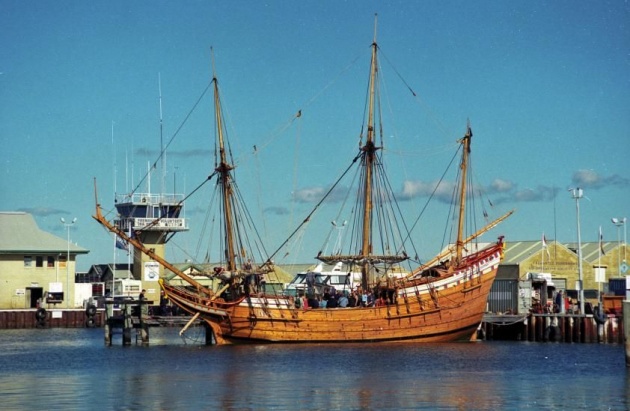
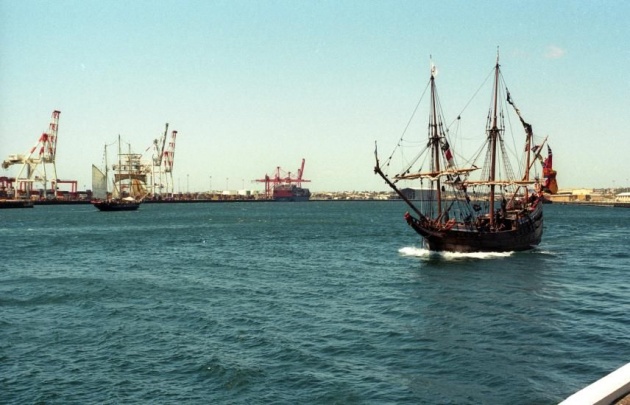
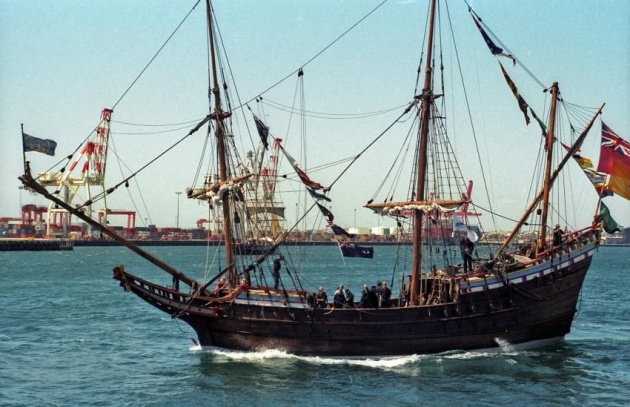
Images copyright by WA Museum. Find more on this source.
While Torres was exploring the Torres strait, the crew of the Dutch ship Duyfken, commanded by Willem Janszoon (1570?-1630?), landed on the Western side of the Cape York Peninsula. They thought they were on the western coast of New Guinea, but they were in fact the first Europeans to set foot in Australia.
Ten years later, while sailing from the Cape of Good Hope to Java, another Dutchman, Dirk Hartog, reached Australia. His little ship, the Eandracht, landed in Western Australia at a spot still marked at Dirk Hartog's island. Hartog wanted to leave a record of his visit, so he took an old tin dinner -plate, scratched a massage on it and nailed it to a post by the shore. This was the message:
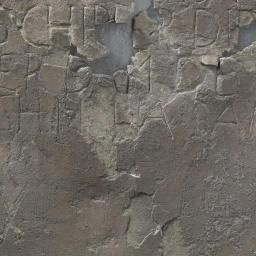
1616
On 25th October there arrived here the ship Eandracht of Amsterdam. First merchant Gilles Miebais of Liege; skipper Dirck Hatichs of Amsterdam. On 27th of the same month she set sail again for Bantam. Second merchant John Stins; upper steersman Pieter Doores of Bil. In the year 1616.
This first tin plate, the first document in the history of Australia, was still in 1697 when Willem de Vlaming, another Dutchman, reached the spot. He took down Hartog's plate and put up one of his own. On it he wrote a copy of Hartog's message and added another to record his own landing. He sent Hartog's plate to the Governor of the East India Company in Hollands.
In 1817 Louis de Freycinet(1779-1842), a Frenchman, landed at the same spot and carried off the plate. After that, both plates were lost many years. Then, in 1902, Hartog's old tin plate was found again among odds and ends in the State Museum of Amsterdam.
Wellim de Vlamingh plate was not found again until 1938, when it turned up, rusty and crumbling, in a French museum. In 1947, after being sent to the British Museum to be repaired, it was given by France to the people of Australia. It is now in the National Library at Canberra.
ABEL TASMAN
The Dutch continued to be interested in Australia. During the mid 1600s Dutch seamen explored parts of the Southern coasts. In 1642 the Dutch East Company decided to explore the rest of the Australian shore-line. They believed that Australia had many fertile regions and that it was rich in precious stones and metals.
Video copyright: This Day in History on Youtube. Credits.
Abel Tasman (1603-59), an experienced sailor, was chosen as commander of the new expedition by Van Deimen, who was the governor of the Dutch East Indies. On his first voyage (1642-3), Tasman discovered what is now known as Tasmania; he called it Van Diemen's Land. He also discovered the west Coasts of the two islands of New Zealand, which he named Staten Land.
On his second voyage to Australia (1644), Tasman charted much of the western coast of the continent, which the Dutch called New Holland.
DAMPIER AND COOK
William Dampier (1652-1715) was the first Englishman to set foot in Australia. A Somerset man, Dampier was typical of his times: he was both a pirate and a scholar, and he loved violin almost as much as he loved discovery and exploration.
He first reached Australia in 1688, while commanding a pirate ship. He returned 11 years later in command of the Roebuck to explore the north-west-coast of the continent. Dampier anchored near Dirk Hartog's island and called the place Shark Bay, the name it has to this day. His description of Australia was gloomy.
It was left to James Cook (1728-79), the son of a poor farm laborer in the Cleveland district of the Yorkshire, to give a brighter picture of the Australian land.
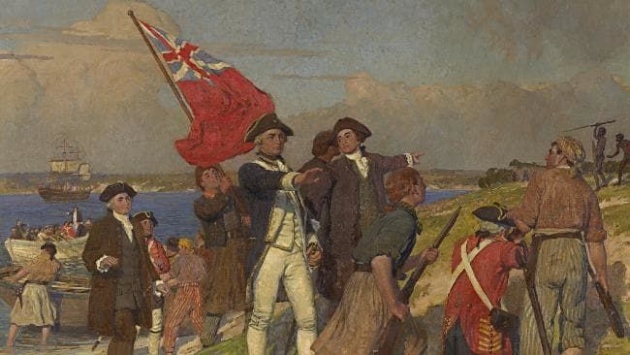
In the picture, James Cook stopped at Botany Bay. Image Credit
As an officer in the Royal Navy, Cook explored and mapped Newfoundland and the St. Lawrence River in Canada. In 1768 he was put in charge of an expedition to the Island of Tahiti in the Pacific Ocean. On the way home from Tahiti, Cook sailed round bottle islands of New Zealand and charted them. Then by chance, he chose to return England by the way of the east coast of Australia. After stopping at Botany Bay and three other places on the east coast, he claimed this land for Great Britain and called it New South Wales. Cook liked what he saw on Australia's eastern coast. He described it as beautiful land, fruitful, and flourishing.
'Here are Provender for more cattle at all seasons of the year than can be brought into this Country,' he wrote.
In 17772, Cook was sent to another expedition to see if there was a land that stretched all the way to the South Pole. He didn't find such a land. But during the three year expedition he made wonderful charts of Australia and New Zealand. He added greatly to man's knowledge of the part of the world. He discovered many South Sea islands and, on 17 January 1773, he became the first person to sail across the Antarctic Circle.
A source of great pride to Cook was the fact that in those three years, though there were many dangers, only one of his crew members died. This was remarkable, for in Cook's day men of the seas usually ate rotten foods and drank foul water; their living quarters were infested with pests. Cook, however, carefully looked after the health of the men who sailed under him. He made sure that their quarters were clean and comfortable. even the enemy respected this noble seaman. His ships sailed the seas in freedom at a time when all other ships under the British flag were being attacked by French warships.
In 1778, Captain Cook discovered the Sandwich (Hawaiian) Islands. He then sailed far North, through the Bering Strait and into the Arctic. Towards the end of 1778 he returned to Hawaii, and on 14 February of the following year he was killed by natives of the island.
THE FIRST SETTLERS
Captain Cook's voyages to Australia occurred at about the same time as the War of American Independence. It had been the British customs to send criminals in America as punishment. When America was no longer available as a kind of overseas goal, Australia was chosen to take the place. The convicts who were sent to Australia were not all serious criminals.
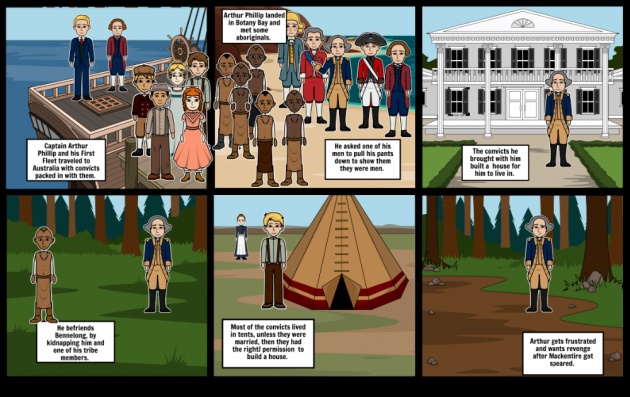
The first shipment of convicts, together with soldiers and officials, set sail from England on 13 May 1787; the ships were commanded by Captain Arthur Philip (1738-1814). There were about 1,500 people on board, including 750 convicts. The 11 ships reached Australia on 18 January 1788. After stopping at Botany bay, where the great city of Sidney was later to be built, they sailed on to Port Jackson. There one of the strangers events in history took place.
On 22 January 1788, as the first European settlers on the Australia continent were being taken ashore, two French Ships under the Comte de La Perouse (1741-88) appeared of the mouth of the harbor. La Perouse had came to claim Australia for France, but he had arrived a day too late; British sailors, soldiers and convicts were already there. After centuries of neglect Australia had been reached in the same week and at the same point by two nations.
La Perouse was one of the finest men in France. He had been chosen to head this expedition because of his great qualities as a leader, scientist and sailor. Before reaching Australia, he had explored many areas of the Pacific Ocean. But for Australia he was too late.
La Perouse took his defeat with grace and good humor and accepted the hospitality of his rivals. He even left his journals with the English, asking that they be sent to France. He then sailed away-and was lost forever. For nearly 40 years no one knew what had happened to La Perouse. Then, in 1826, the mystery was solved. Wreckage from his two ships was found on a coral reef of Vanikoro Island north of the New Hebrides. He and his men must have died there soon after leaving Australia.
SAILING ROUND AUSTRALIA
Another important figure in the early history of Australia was Matthew Flinders (1774-1814).
'If I were dead or buried,' he said, 'and someone pronounced over my coffin the word "exploration", it would bring me to life again.'
Flinders was born in Donington Lincolnshire in 1774. After joining the Royal Navy, he was sent to Australia. There, with his friend George Bass (1771-1803?), he proved that Tasmania is not a part of Australian mainland. He also explored the southern and eastern coast of the continent, and then went on to become the first explorer to sail completely round Australia, thus, providing that it is an island. He was the first too, to suggest the name of Australia for the continent, taking it from the Latin name Terra Australis Incognita ('the unknown land in the south'). Ptolemy of Alexandria, in the second century A.D, had given this name to a land he thought must exist faraway from the south.
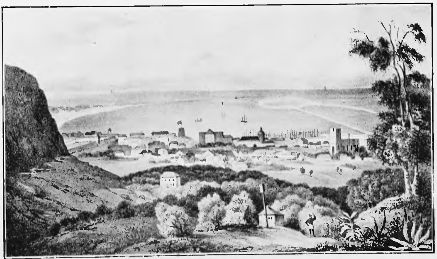
With his work in Australia done, Flinders returned to England and fitted out a new ship. He then sailed to an island of Mauritius, in the Indian ocean. There the splendid tradition of respect between the explorers of France and England came to an end. The French governor of Mauritius took Flinders prisoner and kept him captive for seven years. He stole Flinder's ' books and charts and sent them to France.
Flinders' works remained important to this day. All modern admiralty charts are based on his survey of the Australian coast.
The place-names along the east coast of the Australia record his friendship with his officers and crew.
There was a young midshipman in Flinders' crew who afterwards became a governor of Tasmania. As governor he built a monument there to the lose French explorer la Perouse. To the midshipman himself other monuments have been built, for he was to vanished completely in the northern mists as la Perouse had done in the Pacific Flinders' midshipman was the future Sir John Franklin (1786-1847), who died of cold and starvation while seeking the North-West passage.
DISCOVERY OF NEW ZEALAND
Mention has already been made about the voyage of Abel Tasman, the first European to visit the west coasts of the Island of New Zealand on 13 December 1642. The stretch of the land he saw was the coast of the South Island near Hokitika .
Tasman dropped anchor further north in what is now called Golden Bay. There he first saw the Maoris (Natives of new Zealand), who quickly killed four of his crew. Tasman set sail without even going shore..
After sailing to the northern tip of North Island, Tasman sighted Three Kings island. He planned to land there to look for water and food but the sea is in rocky area. were too dangerous. So he sailed on; Tasman never actually set foot on New Zealand soil. He did, however, chart part of its coasts.
Captain Cook Visits New Zealand
When Captain Cook sailed New Zealand in 1769, he took along a Tahitian named Tupala, who could talk to the Maoris. Cook landed first at Poverty Bay, where the town of Gisborne now stands. There a fright broke out between his sailors and the Maoris. Some of the Maoris where killed and others were prison. Later, meetings with the Maoris went more smoothly, and Captain Cook was able to observe their new way of life.
The natives of New Zealand were very different from Aborigines of Australia. The Australian Aborigines had changed little thousand of years. They had remained ta Stone Age People.
The Maoris were Polynesians, people who lived on many island of the Pacific. They had reached New Zealand by the sea. The Polynesians were good sailors and could travel great distances in their huge double-canoes. These were fitted with sand -pits, used as fireplaces, and carried fowl and pigs for food. Such a canoe could carry 250 men, spend weeks out of sight of the land and travel up to 2,000 miles in a single voyage. In this way, the Maoris reached New Zealand, perhaps as early as A.D. 1350. When the Europeans began to arrive in New Zealand, the Maoris were organized in clans with chieftains. They lived in villages protected by fences made by woods.
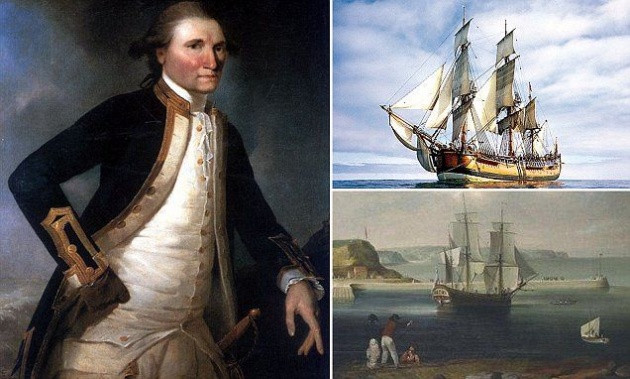
Captain Cook made several stops as he sailed round New Zealand in his ship the Endeavour. In most places, water and food would be taken on board, plant specimens would be collected and the habits of the Maoris would be noted.
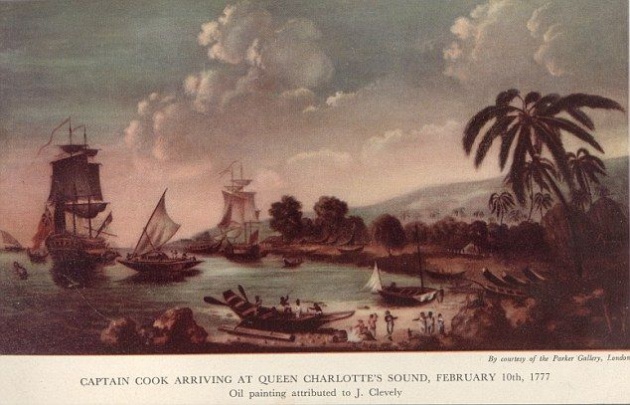
He charted the coasts of both North and South Island and named many of their bays and capes. He also learnt something about the inland areas of New Zealand, being helped at times by friendly Maoris. He claimed the islands for the King. After his first voyage to the New Zealand, there was very little left to discover about its outlines. He returned to New Zealand two more times and used it as a base while he explored other parts of the Pacific. The picture above is his last voyage in the country before he died in Hawaii.
Coming to the Settlers
The name of the first European settlers in New Zealand are unknown. They were men who came ashore from whaling boats or escaped from shipwrecks along the coasts and built themselves crude shelters by the sea. The earliest of them were followed by traders and missionaries. by 1800 there were perhaps 50 Europeans in the country. This casual settlement by one and twos reached its highest point in 1839. By then, there were about 1,000 settlers in the country.
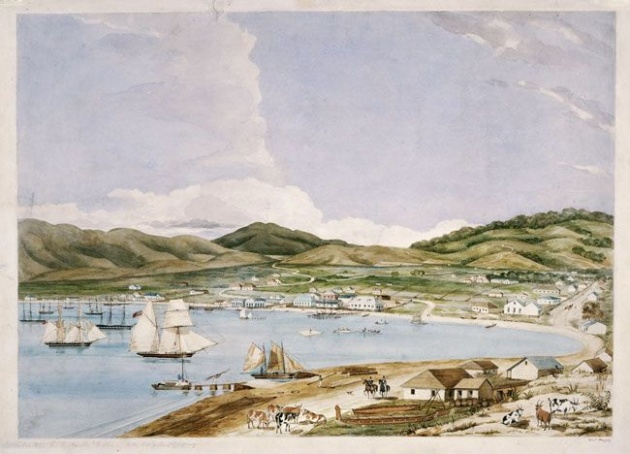
The image is Charles Heapy's painting. Credit to Pukeahu National War Memorial Park. Visit the link for more info of the painting.
After that, planned settlement became the usual thing and a number of companies were set up to arrange. this. The New Zealand company, which was the largest, handled some 12,600 settlers. In the period 1840-50 the number of Europeans in New Zealand increased by 10 times.
People from certain districts tended to keep together. Those from Devon founded New Plymouth, while Scottish settlers chose to live in or near Dunedin.
At first the European settlers and the Maoris lived together peacefully enough. Later there was to be trouble and warfare between them. But in the early days, as today, there was a friendship and equality.
Video copyright: NWO Documentary Channel on Youtube. Credit.
The list credits, by the article, other sources of illustrations, used by the authour of "The Men Who Found Australia and New Zealand." Credit is listed below by separated comma:
Western Australian Museum, Expedia, Research Gate, DailyMail Uk, Pukeahu National war Memoiral Park, MF, Wikisource, W3 Live News and Storyboardthat.
All rights reserved. No part of this article
may be reproduce without special credits in writing from the publishers of Wikipedia and Youtube.



